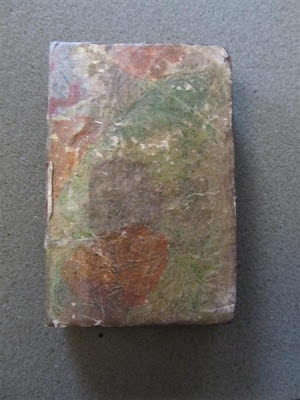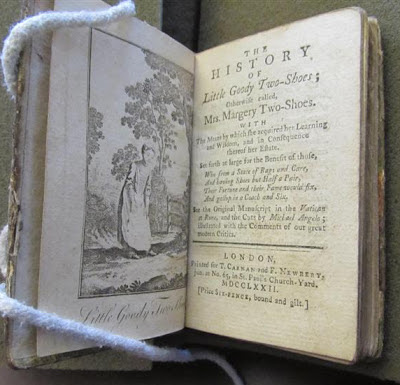This past fall the Rosenbach was joined by a wonderful new class of docents. Their rigorous training included ten weeks of lectures and workshops as well as two written assignments on books and objects in the Rosenbach collections. Over the next few weeks we plan to share a selection of their work; we hope you enjoy it.
– – – – – – – – –
Dr. A.S.W. Rosenbach was a world-renowned bibliophile. While I too have been a lifelong lover of
books (at a much humbler level), I did not feel a personal connection to
“Dr. R.” until I recently had the opportunity to touch, read, and resonate to
his collection of “Goody Two-Shoes” books, centuries-old nursery tales, which
were once part of his personal library and are now part of the Rosenbach Museum
& Library holdings.
books (at a much humbler level), I did not feel a personal connection to
“Dr. R.” until I recently had the opportunity to touch, read, and resonate to
his collection of “Goody Two-Shoes” books, centuries-old nursery tales, which
were once part of his personal library and are now part of the Rosenbach Museum
& Library holdings.
 |
| The history of little Goody Two-Shoes. London : printed for T. Carnan and F. Newbery, 1772. Rosenbach Museum & Library. EL2.A1 go 772 |
The moment the 240-year-old book emerged from its red slip-case, I was smitten: I loved its tiny size, its worn but still lovely Dutch paper covers, its humorously long title, its many charming, miniature wood-cut illustrations, and best of all, the story itself, as told in its 156 pages.
This particular book had been printed in London in 1772 by T. Carnan and F. Newbery, “successors to the late Mr. John Newbery,” the publisher of the original 1765 edition (not in the Rosenbach collection). If we could time-travel, we should be able to pay a visit to Messrs. Carnan and Newbery, because on the second page they thoughtfully provided their exact location, “at the corner of St. Paul’s Church Yard and Ludgate-street,…No. 65, near the Bar …” On the third page yet another variation of the title is provided as the heading to the first chapter.
I have learned that the name “Goody Two-Shoes” has had many applications and connotations: it is the title (or the salient part thereof) of this centuries-old fable; it is one of the sobriquets of the protagonist of this story; and in more modern times, it has morphed into a term of belittlement. In current English slang, a “goody two-shoes” is someone who is cloyingly pious and smugly self-righteous. The term is not considered a compliment today.
 |
| The history of little Goody Two-Shoes. London : printed for T. Carnan and F. Newbery, 1772. Rosenbach Museum & Library. EL2.A1 go 772 |
But once upon a time, Margery Meanwell, a.k.a. Two-Shoes, a.k.a. Little Goody Two-Shoes, a.k.a. Old Goody Two-Shoes, a.k.a Goody Two-Shoes, a.k.a. Mrs. Margery, and yes, eventually the Lady Jones, was a beloved heroine to generations of children, and probably even more so to their parents, who were earnestly endeavoring to instill in their offspring the tenets of Christian virtue, which can be boiled down to “Faith, Hope, and Charity,” plus a good measure of ye olde Protestant work ethic.
This heroine’s slew of names reflect her Cinderella saga, the allegorical tale of an orphaned child who is beset with many misfortunes, but continues to rise through life because of her unshakable piety, her industry and honesty, and her unstinting kindness. In the early chapters, her parents, the Meanwells, are driven from their farm by the cruel Sir Timothy Gripe and Farmer Graspall, leaving the family destitute. The father soon succumbs to a fever, the mother dies of a broken heart, and little Margery and brother Tom are left alone in the world and impoverished, so poor that the little girl has only one shoe. The children are soon befriended by a clergyman and then his rich relative, the Gentleman, who sends Tom off to become a sailor and orders new “cloaths” for Margery, including a pair of shoes. Her grief at the departure of her sibling is mollified by the arrival of her new shoes. She delightedly cries out “two shoes,” which becomes the basis of her classic sobriquet.
The destitute orphan, through diligent study and hard work, becomes a self-sufficient schoolmistress. She is not only a teacher of children, but also a savior of animals, who then magically assume human-like powers and become her faithful companions. In the tradition of heroic sagas, Margery Meanwell, now Miss Goody Two-Shoes, must undergo many tribulations and tests of her faith, including being locked in a church thought by many to be haunted, the destruction of her schoolhouse, the on-going enmity of Sir Timothy Gripe, and more. She is even tried as a witch (and of course acquitted). Ultimately, our flawless paragon is rewarded for her virtue: she becomes the cherished wife of a rich nobleman, is reunited with her long-lost brother, and lives happily ever after, while continuing to bestow her charity upon all who need it.
To my adult surprise and delight, I discovered that what would seem to be an ingenuous allegorical tale is actually laced with sly irony. For example, on the title page, we are directed to “See the Original Manuscript in the Vatican at Rome, and the Cuts by Michael Angelo; illustrated with the Comments of our great Modern Critics.” The wit of the anonymous author shines through the deliberate platitudes with which the story is laden. To reinforce its moral weight, the narrative is salted with interstitial adages such the following: “A friend in your need is a friend indeed”; “Where pride goes, shame will soon follow”; “Honey catches more flies than vinegar.” Ponderous pronouncements are offset by clever turns-of-phrase.
Some literary theorists, including Washington Irving, have attributed its authorship to Oliver Goldsmith; others have disputed this allegation and offered alternative and/or additional candidates, including John Newbery himself, as well as the names of two brothers, Giles and Griffith Jones. As I perused the story in the Rosenbach reading room, it seemed to me that the writing reflects more than one voice, so I find plausible the opinion of some that the original work was a collaborative effort. Indeed, I can imagine that collaboration taking place in a congenial London tavern! However, despite more than two hundred years of speculation and debate, it seems unlikely that authorship will ever be definitively determined.
The destitute orphan, through diligent study and hard work, becomes a self-sufficient schoolmistress. She is not only a teacher of children, but also a savior of animals, who then magically assume human-like powers and become her faithful companions. In the tradition of heroic sagas, Margery Meanwell, now Miss Goody Two-Shoes, must undergo many tribulations and tests of her faith, including being locked in a church thought by many to be haunted, the destruction of her schoolhouse, the on-going enmity of Sir Timothy Gripe, and more. She is even tried as a witch (and of course acquitted). Ultimately, our flawless paragon is rewarded for her virtue: she becomes the cherished wife of a rich nobleman, is reunited with her long-lost brother, and lives happily ever after, while continuing to bestow her charity upon all who need it.
To my adult surprise and delight, I discovered that what would seem to be an ingenuous allegorical tale is actually laced with sly irony. For example, on the title page, we are directed to “See the Original Manuscript in the Vatican at Rome, and the Cuts by Michael Angelo; illustrated with the Comments of our great Modern Critics.” The wit of the anonymous author shines through the deliberate platitudes with which the story is laden. To reinforce its moral weight, the narrative is salted with interstitial adages such the following: “A friend in your need is a friend indeed”; “Where pride goes, shame will soon follow”; “Honey catches more flies than vinegar.” Ponderous pronouncements are offset by clever turns-of-phrase.
Some literary theorists, including Washington Irving, have attributed its authorship to Oliver Goldsmith; others have disputed this allegation and offered alternative and/or additional candidates, including John Newbery himself, as well as the names of two brothers, Giles and Griffith Jones. As I perused the story in the Rosenbach reading room, it seemed to me that the writing reflects more than one voice, so I find plausible the opinion of some that the original work was a collaborative effort. Indeed, I can imagine that collaboration taking place in a congenial London tavern! However, despite more than two hundred years of speculation and debate, it seems unlikely that authorship will ever be definitively determined.
Kerry Bryan is a member
of the Docent Training class 2012 and currently a docent apprentice. Her love
of American History and Literature drew her to the Rosenbach’s collections.
of the Docent Training class 2012 and currently a docent apprentice. Her love
of American History and Literature drew her to the Rosenbach’s collections.

